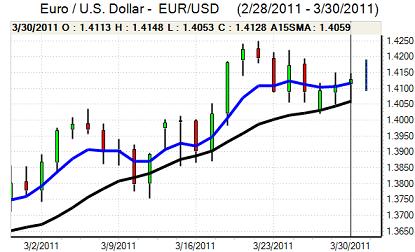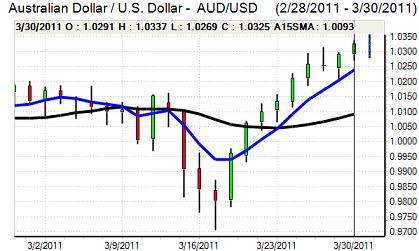EUR/USD
The Euro found support on dips towards 1.4050 against the Euro during Wednesday and rallied to a high near 1.4140 during the New York session with the currency holding firm in Asia on Thursday as the dollar still found it very difficult to gain any significant traction against major currencies.
Markets were looking to concentrate on yield considerations ahead of the ECB council meeting next Thursday. Comments from ECB members have remained consistently hawkish over the past week and there is no sign that the central bank is backing away from a rate hike. Indeed, there has been increased speculation that the bank would either look for a 0.50% rate increase this time or would effectively announce a planned series of increases.
Yield considerations will tend to support the Euro initially, but a series of rate increases has been priced in and the structural vulnerabilities will also remain a very important negative factor, especially with the Irish banking-sector stresses tests likely to show further capital will be required. Markets may again lose confidence in the Euro as sovereign risks intensify.
The US ADP employment data was broadly in line with expectations with a 201,000 private-sector payroll increase for March following a revised 208,000 gain previously and there were expectations of a solid payroll outcome on Friday. There was also further speculation that the Federal Reserve would not look to extend the quantitative easing programme beyond June and could even curtail the existing bond-buying programme early.

Source: VantagePoint Intermarket Analysis Software
Call now and you will be provided with FREE recent forecasts
that are up to 86% accurate * 800-732-5407
If you would rather have the recent forecasts sent to you, please go here
Yen
The dollar maintained a strong tone against the yen during Wednesday and pushed to a high near 83.20 before retreating and testing support levels below 82.80. The yen has continued to be undermined by yield considerations as Treasury yields remain higher following speculation that the Fed will end quantitative easing early.
Carry-trade activity remains important and there has been increased speculation that the yen will be used as a global funding currency, especially if selling the dollar is seen as less attractive.
Underlying confidence in the economy remains weak with the PMI manufacturing index retreating back to below the 50 level in the latest reading. There has also been an increase in overseas bond buying.
There will still be caution over aggressive yen selling and there was evidence of exporter offers above the 83 area.
Sterling
Sterling resisted a further test of support in the 1.5950 area against the dollar on Wednesday and advanced to a high just above 1.61 as the UK currency also strengthened through 0.88 against the Euro.
The UK economic data offered some support to Sterling with the services sector rebounding in January following December’s sharp decline. The data is old, but will increase hopes for a solid first-quarter GDP reading. There was also a stronger than expected CBI retail sales report for March.
Consumer confidence, however, remained at a weak level and there will still be fears that a decline in real incomes will have a serious negative impact on consumer spending which will also derail Sterling over the next few months with the Bank of England still finding it difficult to respond to higher inflation.
The Irish banking-sector stresses tests will be watched closely on Thursday and a higher than expected capital requirement would also tend to unsettle the UK currency.
Swiss franc
The dollar spiked to a high near 0.9270 against the franc on Wednesday, but then retreated rapidly with a low around 0.9170 in Asian trading on Thursday as the Euro found it difficult to hold above 1.30 against the Swiss currency.
The Swiss KOF business confidence index was slightly stronger than expected at 2.24 for March from a revised 2.19 previously and this remains a very high figure historically which will boost confidence in the economy.
There will still be some increase in use of the franc as a carry trade if global confidence improves, but there will also be unease over the potential for capital flight if Euro fears intensify again.

Source: VantagePoint Intermarket Analysis Software
Call now and you will be provided with FREE recent forecasts
that are up to 86% accurate * 800-732-5407
If you would rather have the recent forecasts sent to you, please go here
Australian dollar
The Australian dollar found support below 1.03 against the US currency during Wednesday and pushed to fresh 29-year highs just above 1.0340 during local trading on Thursday.
The domestic data offered some support with a reported 0.5% increase in retail sales for February while there was an increase in private-sector credit, but the building approvals data was sharply weaker than expected which will dampen confidence to some extent.
The currency continued to gain support from a renewed increase in carry-trade activity during the session as equity markets also proved resilient.



